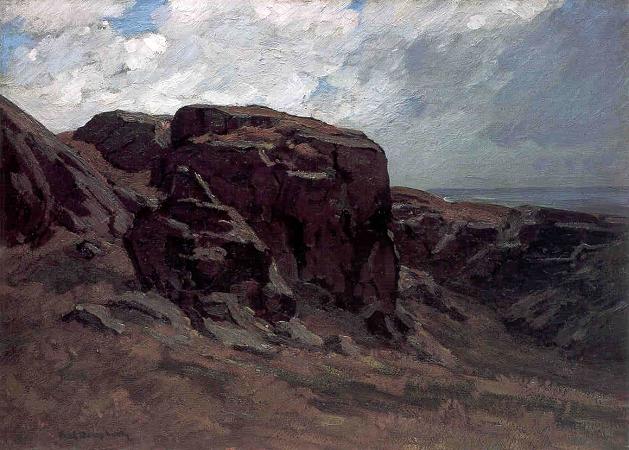Paul Dougherty (1877 - 1947). Paul Hampden Dougherty was an American marine painter. Dougherty was recognized for his American Impressionism paintings of the coasts of Maine and Cornwall in the years after the turn of the 20th Century. His work has been described as bold and masculine, and he was best known for his many paintings of breakers crashing against rocky coasts and mountain landscapes. Dougherty also painted still lifes, created prints and sculpted. The son of a prominent attorney, Dougherty graduated from law school and passed the bar, but chose art over the law. His artistic training was relatively brief. An erudite man and a world traveler, Dougherty sketched and exhibited extensively on both the east and west coasts of the United States, in the British Isles, throughout Europe and in Asia. He spent the first half of his career based in the east, but he moved west in 1928 and eventually spent the summers in Carmel, California and the cooler winter months in the desert. Dougherty won almost every major award at the annual exhibitions of the National Academy of Design in New York, as well as a Gold Medal at the Panama-Pacific International Exposition in San Francisco. By 1915 many American museums had purchased his works for their permanent collections. He was elected to membership of the National Academy of Design. Paul Dougherty was born in Brooklyn, New York. He was the eldest of six children born to J. Hampden Dougherty, a prominent attorney, legal scholar and leader of the New York State Bar Association. While his father wanted to see him pursue a career in law, Dougherty was always drawn to art, and sketched and painted incessantly. He graduated from Brooklyn Polytechnic Institute in 1896 where he received some training in art. His talent in art was always apparent and by the time he was eighteen one of his works was accepted for the Annual Exhibition of the National Academy of Design. In spite of his artistic abilities, he diligently followed through on his education and graduated from New York Law School and passed the bar, but he was never to practice law. Information on his artistic training can be contradictory and sketchy. In filling out an information card for the National Academy, he stated that he studied with the noted landscape painter Henry Ward Ranger in 1897, which is the only formal training he mentioned. However, there are accounts that he studied with the innovative ship designer and marine painter William S. Barnett from Rockport, Maine, who had been living in Brooklyn since 1885 when he returned from his studies at the Académie Julian. Dougherty did share a studio in Brooklyn early in his career with Barnett as well as Gustave Wiegland, George McCord and Harry Roseland. About 1901 these artists were joined by Frederick and Joseph Boston, Charles Burlingame, Edward Rorke, and Benjamin Eggleston in forming The Brooklyn Ten which then became known as The Society of Brooklyn Painters. The first annual exhibition of the society was held at the Hooper Gallery on Fulton Street in Brooklyn in 1903. In order to advance his studies, Dougherty and his younger brother, the stage actor Walter Hampden Dougherty, left on an extended trip to Europe. On this sojurn, he sketched and painted throughout the continent and studied the Old Masters in museums in order to educate himself. Munich, Venice, Paris and Florence were all stops on the Dougherty brother's European tour. In 1901 Dougherty sent a landscape painting home for the annual exhibit of the National Academy of Design and he showed his landscapes with the Academy for the next several years. In Paris he met a young Swedish music student named Antje Berthe Lund and they were married in 1902. The Doughertys returned to America and the artist opened a home and studio in Nutley, New Jersey, where their daughter Lisa was born. Tragically, Antje Dougherty died of appendicitis just weeks later. Soon after returning to the United States, Dougherty began to work on Monhegan Island, Maine, an area which was already a famous summer place for painters. In Maine, the young painter began to build his first significant body of the marine paintings he would become known for and the dramatic views of the Island offered him a host of subjects. He joined the Society of American Artists in 1904, a group of younger painters who had broken away from the National Academy years before because it was then dominated by the aging members of the Hudson River School. When the Society merged with the National Academy in 1905, Dougherty automatically became an Associate Member. In 1907 he had his first exhibition at the William Macbeth's Macbeth Gallery in New York City. Irish born William Macbeth was the first dealer to only represent American artists and he opened his first gallery in 1892.
more...







